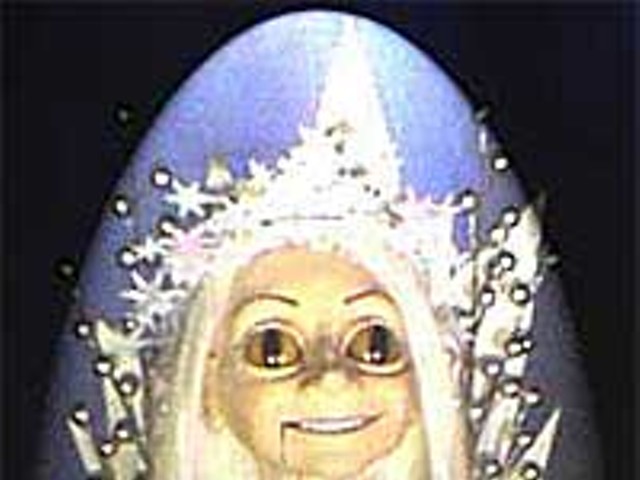In 1981, Michael Luchs’ star was burning bright in Detroit’s art firmament and beyond. He’d recently been featured in the Detroit Institute of Arts blockbuster, Kick Out the Jams: Detroit’s Cass Corridor, 1963-1977 (which also traveled to Chicago’s Museum of Contemporary Art), and written up in Art in America as part of a major spread on the city’s rough-and-tumble art scene.
That year, a local collector bought the entire set of Luchs’ works on paper and plywood from his solo show at Feigenson Gallery, run by late Faygo heiress, Cass Corridor booster and sculptor Jackie Feigenson. The hefty purchase helped the then fortysomething artist set up shop in New York City. The work lay under wraps for more than two decades, until it was shown recently to Birmingham dealer David Klein, who now has 11 of the pieces on consignment at the David Klein Gallery.
The series of untitled works employs Luchs’ signature motif from that period: the rabbit, which occupies the center of each composition. During his heyday, Luchs rendered his trademark in weathered scrap lumber, rusted barbed wire, a ratty found leather jacket and, like a precursor to TRTL, in images spread throughout the city like a graffiti writer out to tag all of Motown. Subjected to serious abuse by the artist as part of his creative process, the work today looks like something from a prehistoric archeological dig or a postindustrial landfill. In any case, it’s a wonder to behold.
While they all share the same iconic image, each individual work is unique in terms of the techniques used to create it. In some pieces, the rabbit is buried under skeins of sprayed or smeared enamel paint; in others, it emerges from the negative space of heavily worked areas defining the contours around its shape. In the more visceral works, the rabbit outline is forcefully scratched into the surface of the paper, which is barely held together by layers of duct tape applied to the back. The metallic sheen of gold, silver and copper in some pieces has a primordial presence, while the frailty of the collaged elements in others seems to threaten disintegration at any moment.
This dichotomy of the timeless and the ephemeral is part of what makes Luchs’ work from 20 years ago still significant. On one level, it’s the ars longa, vita brevis (“art is long, life is short”) philosophy. Luchs’ art is an existential protest of a way of life slipping away; the response of an artist to a city, once the dynamo of the modern age, in the process of falling into ruin. Looking at Luchs’ work today is a reminder of just how much things have indeed changed. The art endures, however, still resonating with the creative spirit that brought these material objects into being. There’s also something about the specific conditions under which the work was made that links the Detroit art scene of the time to broader currents.
In promoting the Cass Corridor movement (an outgrowth of the legendary Detroit Artists’ Workshop), art world gatekeepers like then DIA curator Jay Belloli came up with the term “urban expressionism” to distinguish it from the cool objectivity of minimalism and the dry immateriality of conceptual art that, at the time, ruled aesthetic theory. As the argument went, the deeply committed and physical Cass Corridor work was noteworthy as a regional countercurrent to the so-called mainstream emanating from New York. But instead of being reactionary, the Cass Corridor was right on trend.
The Whitney Museum of American Art declared the birth of “New Image Painting” in 1978, and neo-expressionism was in full swing by the time of Luchs’ 1981 Feigenson Gallery show. Luchs can be considered a pioneer of what we now call postmodernist art, alongside Julian Schnabel, Susan Rothenberg and especially Anselm Keifer, whose forest mythology pieces are artistic cousins of Luchs’ rabbits.
Romantic self-determination permeates the best Cass Corridor art, and the bootstrapping aesthetic of Luchs’ rabbits exemplifies it.
Method and materials seem invented anew from work to work. There isn’t any indication of formal art training, and not a conventional brushstroke is visible. The materials are nontraditional and commonplace: industrial enamel, sign maker’s stencils, duct tape, carpenter’s staples, etc. Luchs is totally in command every step of the way; it’s the will to art, pure and simple.
And, of course, there’s the rabbit itself, symbol of the natural order furtively and steadfastly persisting beneath the built-up world of industrial technology that sought to rule over it. The age of mechanical mass production has come and gone, and much of Detroit has reverted to open field. The world goes on in spite of it all, as it always seems to do.
The rabbit has often been read as representing Luchs himself, a persona at once feral and vulnerable.
But we can take greater comfort in recognizing that there is more than a little bit of Luchs’ rabbit abiding in each one of us.
Rabbits: Works on Paper by Michael Luchs runs through the end of December at David Klein Gallery, 163 Townsend (opposite the Townsend Hotel), Birmingham; 248-433-3700. Vince Carducci writes about art for Metro Times. Send comments to [email protected]





